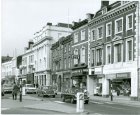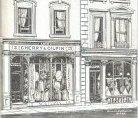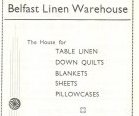Bedford
High Street History
Places > Bedford > Streets > High Street
Belfast Linen Warehouse - Drapers
11 High Street
Home | Belfast Linen Warehouse | Sources | Images
Belfast Linen Warehouse and the History of 11 High Street
 In
the last quarter of the C19 Bedford was expanding. By 1870 Bedford had gas
street lighting and railway links with Bletchley, Leicester, Hitchin and St.
Pancras. The development of the railway links led to a decline in the use of the
river for transporting goods but allowed more people from farther afield to
easily reach the town. The 1871 Census records Bedford as having a population of
16,849. It was a town well served with drapery shops. A fact that seems to
have escaped attention from historians is that of competition between similar
businesses. For example, The Post Office Directory of 1869 lists a total of 17
drapery businesses in the High Street (1) competing with one another as well as
with drapery businesses in other parts of the town.
In
the last quarter of the C19 Bedford was expanding. By 1870 Bedford had gas
street lighting and railway links with Bletchley, Leicester, Hitchin and St.
Pancras. The development of the railway links led to a decline in the use of the
river for transporting goods but allowed more people from farther afield to
easily reach the town. The 1871 Census records Bedford as having a population of
16,849. It was a town well served with drapery shops. A fact that seems to
have escaped attention from historians is that of competition between similar
businesses. For example, The Post Office Directory of 1869 lists a total of 17
drapery businesses in the High Street (1) competing with one another as well as
with drapery businesses in other parts of the town.
According to Bedford Borough Councils, Bedford High Street Heritage Gazetteer of November 2008, 11 Bedford High Street was constructed in the late C18 by an as yet unidentified architect. The Post Office Directory of 1869 shows Henry Adkin, Gun, rifle & pistol maker at 11 High Street. He is not listed amongst private residents of Bedford and probably lived above the shop. Barry Stephensons research on Henry Adkins business has ascertained that he had moved there c.1861 and remained until 1872. He is shown as resident there in the 1871 Census. Cherry & Gilpin, drapers are listed as next door at No.13.
The County Advertisements section of Kellys Directory of Bedfordshire 1890, shows William Gilpin, now both at 11 & 13 High Street, as a Draper, Silk Mercer and etc., also listing millinery; mantles; dressmaking; wedding trousseaux; India outfits and Funerals Conducted. In the list of private residents he is shown as living at 55 The Grove, Bedford, about half a mile away. Where to Buy at Bedford, 1891 has an etching showing 11 and 13 High Street, owned by Mr W. Gilpin, Draper etc. and describes it as one of the elegant establishments in the High Street, an old-established and well organised concern with each department kept as distinct as is found practicable, and each having its own particular staff of assistants. The three-storied elevation extends some way to the rear and the shop provided dress, mantle making and millinery. (2)
William Gilpins death at the age of 70 on 10th December 1903 and his funeral on 14th December 1903, were recorded in the Bedford Times and Independent of 11th and 18th December 1903 with details of his family. He had married Elizabeth Smith of Elstow; had a son who became a doctor in Bourne, Lincolnshire; a daughter who married the Chief Constable of the Borough; and another daughter who married a barrister-at-law in Margate, Kent. William Gilpin had come to Bedford in 1854 and established a partnership with Mr Luke Cherry, who predeceased him. Having retired c. 1891, William Gilpin had held various public positions, including in 1887 being elected as a member of the Bedford Board of Guardians for the parish of St. Cuthbert (in which he lived), in which role he showed kindly consideration for the poor. He had also been a member and Chairman of the Burial Board but retired in approximately 1902 on account of his deafness; a Governor of the County Hospital (now Bedford Hospital South Wing); an Income Tax Commissioner and a Trustee of Bedford Savings Bank. This suggests his business was doing well enough for him to be able to employ reliable employees enabling him to spend a substantial amount of time away from his business. He is buried in Bedford Cemetery in Foster Hill Road.
The commercial section of Kellys Directory of Bedfordshire 1894 (the year that electricity was introduced to Bedford) shows William Kirkbride (late Cherry & Gilpin) occupying 11 and 13 High Street as draper and silk mercer and funeral furnisher, novelties and specialities in costumes, mantles, millinery and lace goods, wedding trousseaux and Indian & Colonial outfits a speciality. The business features in the County Advertisement section and William Kirkbride is listed in the residential section as living at 46 Gery Street, Bedford.
By 1901, Bedford had a population of 35,000 and the census that year shows 11 and 13 High Street occupied by Arthur Field Pearman (aged 39), his wife Amy Elizabeth (32) and a son, John Lloyd Pearman (2). Also listed are Wilhelmina B. Hanson (32), Alice Reynolds (37), Florence Hill (29), Ethel Maud Hawkins (24), Florence Amy Stream (26), Bertha Hammett (71), Kathleen Sanders (19) and Edith Ann Sanders (23). Apart from the aged Bertha, it is likely that most of the younger women were assistants or apprentices in the shop, with one or two possibly being domestic servants. The shop must have been doing well to support so many people. Kellys Directory of Bedfordshire of 1903 lists Arthur Field Pearmain as a draper at 11 and 13 High Street (note the variation in the spelling of the surname; census information was completed by the census taker, not the occupants themselves).
In the 1911 Census, 11 and 13 High Street are still conjoined, but after 1925 they became separated. Arthur Day took over No. 13 in 1926 and by 1928 the Belfast Linen Warehouse was established at No. 11. By this period Bedford was expanding again and the 1931 Census shows the towns population as 42,606. The Bedford Directory of 1936 lists the proprietor of The Belfast Linen Warehouse at 11 High Street, as Ingram Stephen Hubbard and includes an advertisement for the business.
The Belfast Linen Warehouses website provides a brief history of the firm which was founded by Harold Nichols. Nichols, an ambitious young man who, having learned the linen sales trade in Birmingham and saved 100 (a very substantial amount then), wanted to be his own boss. Prior to WW1 he bought a leasehold property in Cambridge and named it Belfast Linen to prompt associations with the quality linen warehouses in Belfast. By 1914 he had another shop in Kings Lynn which he left to be run by his youngest, and only unmarried sister, whilst he served in a cavalry unit. On his return he bought two more stores, one of which was 11 High Street, Bedford. This and his other shops thrived until the outbreak of WW2 in 1939 (his sons Douglas and Kenneth served as Spitfire pilots) when it became impossible to acquire new stock, but Harold Nichols kept his remaining stock and resumed trading in 1946. The 1947 Bedford Street Directory records J. S. Hubbard as proprietor. (3)
A Bedford Diary of Four War Years 1939-43 by H. Barker, provides some vivid details about shop keeping in Bedford from the declaration of war on 3rd September 1939 up to 1943. On 4th September 1939, 'wooden barriers were erected on the plate-glass windows on the High Street... Shopkeepers held meetings at which they decided to close at 6 pm'. However on 9th November 1939, a special meeting of Bedford Town Council took place at which it was agreed to extend shopping hours by one hour to 7 pm from Mondays to Fridays and 8 pm on Saturdays. 'A modified form of shop window lighting was granted to shopkeepers during the Christmas season. The lights were permitted only when the shop was open and had to be turned out on an air raid being sounded.
It appears that the Belfast Linen Warehouse was on a lease as 11 High Street was put up for sale by auction on 7th March 1956 by joint auctioneers W. and H. Peacock, 6 Dame Alice Street, Bedford and Wm Houghton and Sons (Valuers) Ltd., 7 and 8 Chandos Street, London W1.(4)
Kellys Directory of Bedford and Neighbourhood 1961 shows only three High Street drapery businesses: at No. 11, Belfast Linen Warehouse household and fancy linen, soft furnishings and dress fabrics ; E.P. Rose department store at Nos. 45-54 and B and W Linen Shops Ltd. at No. 82 High Street.
Ten years later, Kellys Directory of Bedford and Kempston 1970/71 shows that the Belfast Linen Warehouse at No. 11 and E. P. Rose department store are still in the High Street. B and W Linen shop has gone, but Shalets drapers is now at No.44. In the space of a century, competition between High Street drapery businesses has significantly reduced, there is a market for ready-made textiles, both clothes and furnishing and make do and mend becomes increasingly replaced with cheap factory made imported goods which are not expected to last. At my primary school in Kent in the mid 1940s, girls were taught how to sew on buttons and darn socks!
In November 2010, on a visit to Bedford Librarys Turn Back Time display, L. D. wrote down her memories of shopping at the Belfast Linen Warehouse over several decades: The Belfast Linen Warehouse was a very well-used and popular shop that we used regularly. They had an excellent variety of household linens at very reasonable prices. I left Bedford in the early fifties but on return visits when much of the High Street closed and changed, Belfast Linen traded on in the same shop and with quality items - I remember buying items for presents I remember buying themed tea towels I even took one on the theme of John Bunyan out to West Africa where I worked. My friends there felt I didnt know enough about the man but he was before my time! The writer said she had worked in West Africa for 19 years.
The Belfast Linen Warehouse continued at No.11 High Street until c.1995 when, along with the other 20 shops that the chain had expanded to, the firm turned away from linen supplies owing to the increasing competition from hypermarkets and internet shopping.
Notes
(1) At Nos. 46, 97, 27, 13, 23, 70, 50, 83, 40, 89, 54, 75, 81,
21, 7, 77 High Street, Bedford and one other for which the number is not specified.
(2) On the subject of the draper see Brenda Fraser-Newstead, Bedfordshire's
Yesteryears vol. 3 Craftsmen and Trades-people. The Book Castle, 1995
pp.100-5. 'Traditional shopping is all about relationships between customer and retailer,
quality and service - good advice, good quality products, excellent service.
This was personalised shopping where the business bonded with the community.'
(3)The German U-boat blockading of shipping largely halted the importation of
goods. Attempts to import food took priority over textiles. From 1st September 1939 street
lamps were turned off and the blackout regulations instituted and rigorously
enforced. The material for preventing light escaping from windows and doors had
to be sold at a reasonable price. The introduction of clothing rationing on
1st June 1941 and the introduction of regulations requiring clothes to be made of
cheap materials reduced the market for dress materials.
(4) The auction particulars for No. 11 High Street, Bedford described the property thus,
'Frontage about 14 ft 6 ins, depth about 128 ft 6 ins with ample accommodation
on the upper floors of the front and rear portions of the property..' It
also mentioned that the average turnover of the last three years averaged
30,000 approximately
Cathy Moorhouse 2011
Sources
Bedford Local Studies Library and Heritage Library (HL)
Books
- Censuses
- Local Directories (HL):
Post Office Directory Northants, Hunts and Beds, 1869
Kelly's Directory of Beds, Hunts and Northants, 1890, 1894, 1903
Bedford Directory, 1936, 1947, 1961, 1970 -
Bedford Borough Council. High Street Historical Gazetteer, 2008 (includes images and a brief outline of the history of each High Street property). This can also be viewed online at www.bedford.gov.uk
In the search box enter High Street Renaissance' -
Baker, A.E. and Wilde, N.C., Bedford in Times Past, Countryside Publications, 1980. BED/BAK
Has a photograph of the High Street in the late 1930s which includes the Belfast Linen Warehouse -
Barker, H. A Bedford Diary of Four War Years 1939-43. BED/BAR
-
Fraser-Newstead, Brenda, Bedfordshire's Yesteryears vol.3 Craftsmen and Tradespeople, The Book Castle, 1995. COU/FRA
-
Where to Buy at Bedford: an illustrated local review, 1891. HL BED/WHE
Articles
- Bedfordshire County Life Magazine, Winter 2010 pp.16-18. The Lost High Street and the Changing Face of Familiar Vistas
- Bedfordshire Times and Independent 11th December 1903. Death of William Gilpin
- Bedfordshire Times and Independent 18th December 1903. Death of William Gilpin
BLARS
- W and H Peacock and Wm Houghton and Sons auction particulars for
11 High Street, Bedford, 1956
Includes photograph of front of property.
Web
- History of the Belfast Linen shops blt beds
Images
Page last updated: 28th January 2014


